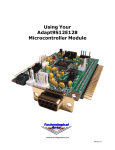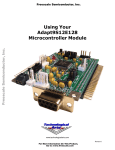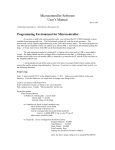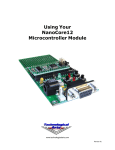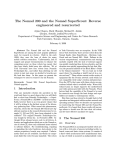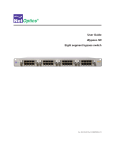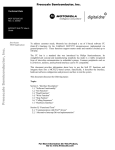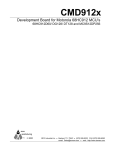Download Using Your Adapt9S12DP256 Evaluation Package
Transcript
Using Your Adapt9S12DP256 Evaluation Package www.technologicalarts.com Revison 0b 1 1 INTRODUCTION Congratulations! With Adapt9S12DP256, you are now ready to explore the power and flexibility of Motorola’s most advanced 16-bit microcontroller! Whether you’re new to Motorola microcontrollers or you’ve used some of the earlier ones, such as 68HC05, 68HC11, or 68HC12, you’ll be impressed with the well thought-out design and implementation of the HCS12 family. And Adapt9S12DP256 gives you the opportunity to explore this MCUs potential at an incredibly affordable price! Add to that the proven advantages of the modular design approach, and the wide variety of available accessories, and you’ll see why you picked a real winner! Support To help you get the most out of this product, and to make the experience as enjoyable and productive as possible, we have put together a comprehensive website with technical support, resources, and applications information. If you experience any difficulties, or need help with your application, the World Wide Web is arguably the most valuable resource available to you. There you’ll find the latest information, software, and troubleshooting help, as well as discussion groups where you can network with people around the globe to get the answers you need. So if you still need help, or have questions after reading this manual, visit our website: www.technologicalarts. com and tap into the collective! The 9S12DP256 in Perspective Adapt9S12DP256 was designed as an evaluation and application tool for the Motorola 9S12 microcontroller family. Based on the most feature-packed flavour of the chip, 9S12DP256, it is perfect for developing applications for any of the lower-function derivatives. The “D” series includes DP256, DT128, DG256, DJ256, etc. All of these feature some at least one CAN or J1850 interface, popular in automotive and industrial applications. The lower-cost “A” series excludes these subsystems. All the other subsystems are identical, however, with the differentiating factor being the amounts each memory type and the quantity of I/O lines. Adapt12 vs. traditional evaluation boards Most evaluation and development systems available tend to be too expensive and bulky for embedding into a real application, so it lies gathering dust once you’ve reached a certain point in the learning curve. Or maybe you have to come up with clever ways to hack it apart to make it fit inside your robot. Even then, the prototyping area provided is often limited, and does not lend itself to re-usability. And what if you burn out a motor driver chip the night before the contest? What a mess to repair or re-design! The Adapt12 system solves all of these problems and then some! Since it brings out all I/O lines and control signals to two standard 50-pin interface connectors, it is modular and re-usable. Interface cards can be unplugged and upgraded, or the whole system can be re-configured at the last minute. And with several connector options to choose from, you can use the module in whatever way best suits your needs-- board-stacking, end-to- end (planar), backplane, ribbon cables, etc. A full range of accesories including backplanes, prototyping cards, and application-specific cards is available, and more accessories are being developed all the time. Visit our website frequently to see what’s new. The connector options (“RA1”) supplied in the Evaluation Package support the use of prototyping cards on each of the H1 and H2 I/O connectors, forming a planar arrangement. Advantages of this configuration are easy access of all I/O pins for probing and measurement, and easy prototyping of your interface circuits. What’s more, the detachable nature of the prototyping cards means that you can easily replace them with other cards, including some of the application cards 2 available from Technological Arts. You can build up a collection of different application circuits, and use them all with the same microcontroller board. This is especially advantageous in an educational environment, where the student can progress from simple to more complex applications throughout a semester, or from one course to the next-- perhaps even using the board in a final project. In fact, where budgets are tight, different students can share the same microcontroller module, and plug in their own interface cards when it’s their turn to use it. Using Adapt9S12DP256 with Solderless Breadboards When used with an optional adapter (#ADHDR50-F), the module will easily plug vertically into any standard solderless breadboard. The resulting footprint is equivalent to a 50-pin narrow DIP, and has a similar pin-numbering sequence (ie. wraps around the end, from pin 25 to 26). Plug the adapter into your breadboard, wire up your circuits, as required, and then plug the module into the adapter. Now you can use DBug12 to load your code into the MCU to evaluate and develop your application ideas. If you want to access signals on H2 as well, you’ll need a 50-pin ribbon cable and a breadboard adapter (#ADIDC50-M) to bring those signals down to the breadboard. Perhaps a better alternative is a planar configuration utilizing cards mounted with solderless breadboards that plug into H1 and H2 in place of the supplied prototyping cards. These cards (#AD12SBH1-FRA1 and #AD12SBH2-FRA1, respectively) feature dual-row receptacles (“F”-style connector) next to the breadboard section, giving you easy access to all of the I/O signals. To build your circuit, it’s just a matter of plugging wires between the signals on the receptacles and the places you need them on the breadboard. Expanded Mode Operation A second jumper block (JB1) is provided for setting MODA and MODB logic levels. These levels are sensed by the MCU after reset to determine the chip’s operating mode (single-chip, narrow expanded, or wide expanded memory modes). You will normally run the MCU in single-chip mode, so that DBug12 functions are available. In this mode, all I/O ports are available for user applications. In expanded modes, the multiplexed address and data bus lines are formed from PORTA, PORTB, and PORTK on the second 50-pin connector, H2, and are thus not available as I/O ports. When operated in this mode, additional memory can be added externally. Communications Two RS-232-compatible serial interface ports (RX & TX only) are included on Adapt9S12DP256, allowing communication with a PC, or any other device which has an RS-232 serial port. The primary RS232 channel (implemented on SCI0 of the MCU) is available via the usual 9-pin D-sub connector. The second RS232 port (implemented via SCI1 of the MCU) is brought 3 out to a common 4-pin Molex connector. Optional mating connectors and serial cables compatible with this connector are available from Technological Arts. To maximize versatility, the logic-level RXD and TXD signals from both SCIs of the MCU are also brought out to the 50-pin headers, for applications such as MIDI, or for use as general purpose I/O lines. For these applications, jumper wires on the board can be cut or removed, if necessary. A factory-installed RS485 option can be accomodated in place of the second RS232 interface, on OEM versions of the module. RS-485 is commonly used in networking industrial control applications, where long cable lengths and good noise immunity are re quired. In passing, it should be mentioned that the MCU supports up to three SPI links, and IIC (also called I2C). Since these are logic-level protocols for local communications among peripheral chips, no transceivers are required nor provided. Commonly used SPI and I2C chips include serial memory, temperature controllers, clock/calendar chips, DACs, MP3 decoders, etc. See the MCU datasheets for details on these subsystems. Networks Up to five Controller Area Networks (CANs) can be accomodated by the MCU. The module provides physical interface transceivers for the first two. The default board configuration dedicates these pins to CAN because it connects them to the CAN transceivers. If you wish to use the pins as general purpose I/O lines instead, it may be necessary to cut one or more circuit board links associated with them. 2 GETTING STARTED Power A 12VDC 300mA power supply is included with the Evaluation Package. It is the recommended power source when you’re starting out. If for some reason it’s not convenient (eg. you don’t want an extension cord trailing around behind your robot), you can power the module in one of two ways: Option 1: connect a DC voltage of 5 Volts or more (maximum 24VDC) via the external power connector, J1. Your DC supply does not need to be regulated, but should be capable of supplying at least 100 mA (more if you will be using a BDM pod, or you’re driving other circuits as well). If your supply is also driving motors, make sure to isolate it before feeding it into the module (to protect it from electrical noise generated by the motor coils). You can do this by putting inductors (10uH, nominal) in series with both the + and - leads. Preferably, use the red & black power wire provided. Red is positive, and black is negative (ground). CAUTION! Make sure you have the polarity correct! Option 2: supply regulated 5VDC via the appropriate pins on the 50-pin connector (H1). See module pinout diagram or schematic included with your manual for the 5V and GROUND pins to connect to on H1. CAUTION! Double-check your connections before applying power! Starting DBug12 To run the program that’s in Flash (DBug12, if you haven’t already erased it) select EVB mode by setting both MODE SELECT jumpers (on JB3) to the 0 position. Connect the supplied serial cable between the 9-pin connector on your module and a serial port on your computer. (With some PCs, you will need a 9-pin to 25-pin adapter.) Run any terminal program on your PC. Make sure your terminal program is set to 9600, parity to NONE, # DATA BITS = 8, and #STOP BITS = 1, and Flow Control set to “Software” or “XON/XOFF”. Apply power to the module, or press the RESET button (SW1). The DBug12 prompt will appear in your terminal window. Type HELP to get a list of DBug12 commands. 4 At this point, you should refer to the DBug12 Reference Guide, included on the accompanying CD-ROM, to continue exploring DBug12. The Demo Program We’ve included our standard demo program on the CD-ROM to give you a starting point. This program was written in assembler, and the sourcecode is included so you’re free to hack it all you want! There are two versions that can be used with DBug12: one is meant to be loaded into RAM and launched from the monitor prompt (ie. EVB Mode), and the other resides in Flash, and is loaded in Bootload Mode. Both versions use pseudo-vectors. (See DBug12 Reference Guide if you’re not familiar with these modes or with the concept of pseudo-vectors). A third, standalone, version of the demo program has “true vectors”. To load this demo program into a blank target chip, you’ll need to use a BDM pod that supports the 9S12DP256. Some possibilities are: a second Adapt9S12DP256 module jumpered for Pod Mode, our MicroBDM12DX, or our MicroBDM12SX product. By the way, the s19 file for this version of the demo has been run through the SrecCvrt utility supplied with DBug12. This utility reformats the s19 file generated by the assembler so that all s1 records have an even number of bytes, and start on an even address, as these are the requirements for programming the Flash memory. There’s more on this in the section called “Migrating from the HC912” a little further on in this manual. New to Motorola MCUs? If you’ve come from an 8051, PIC, or other background (or have never used microcontrollers before), you should get up to speed on Motorola MCUs by reading Understanding Small Microcontrollers, found on the CD-ROM. Written by Motorola’s Jim Sibigtroth, principle design engineer of the HC12 family, this book uses an earlier MCU (68HC05) to introduce you to the basic concepts and design philosophy. Migrating from 68HC11 If you are already experienced with the 68HC11 family of microcontrollers, writing programs for the HCS12 family will not present a big challenge. In fact, you can use your existing 68HC11 assembly code and re-assemble it to run on the CPU12 core, but there are a few things to keep in mind. Assembler syntax. You may need to edit your source file to conform to the syntax and directives requirements of the HC12 assembler you’ll be using. There are several assemblers available (eg. AS12, MiniIDE, IASM12, MCUez), and each has its own syntax to be aware of. Register Block. Instead of $1000, the register block default location is $0000, and there are well over a hundred registers! You’ll need to locate the relevant registers for the subsystems you plan to use, and make sure they are properly configured. RAM location. The RAM starts at $1000 and goes to $3FFF. This means you would initialize the Stack Pointer to $4000 (on the HC12, the stack pointer points to the address following the top of the stack). High-speed Bus. The default bus speed is half the crystal frequency of 16 MHz, so it is 8 MHz. If you enable the PLL, it will be even higher (up to 24 MHz). This will mean changing some initialization values for control registers and revising delay constants if you are using any software timing loops. I/O Ports. The digital I/O ports on the HCS12 are more flexible than ever. Besides selecting the direction of each port pin via a Data Direction Register, there are registers controlling output drive level (standard and reduced), internal pullup and pulldown resistors, and output logic polarity (ie. true or inverted logic). COP Watchdog. On most flavours of HC11, this was enable via a bit in the non-volatile CONFIG register. On the HC12, it is dynamic, and automatically enabled following reset. Therefore you have to choose whether you’re going to service it, or disable it. 5 Write-Once Registers. On the HC12, there is no 64-cycle startup window in which you have to write all the protected registers. Instead, the HC12 implements a WriteOnce rule on sensitie registers. What this means is that, following reset, you have one chance to write them, then they become ReadOnly. The advantage of this is that you have more control of when you alter these register values. To take advantage of this safeguard, you should initialize all the registers that are crucial, even if the default values are what you want. That way, if your code runs amok, or there are any glitches which try to change register values, they will be protected. There are many more differences, and you should make sure to read through the Motorola App Note (AN1284) on the CD-ROM that details the new instructions and addressing modes of the 68HC12, explaining differences from the 68HC11. The book Programming the Motorola 68HC12 Family (#PMM929, available from Technological Arts) thoroughly covers all the subsystems of the 68HC12, providing highlights of the differences with respect to 68HC11, and is recommended reading. Migrating from the 68HC912 You gain a lot more speed, memory, and flexibility, but you have a lot more registers to think about, and many of their addresses have changed. Gone are the Vfp generator and Flash voltage switch, since the new Flash technology uses 5V, and has built-in self-timed algorithms for program and erase functions. But your s-records must contain an even number of bytes, and begin on an even address boundary if you’re going to “burn” them into Flash. Some assemblers will generate this format for you but others, such as the included AS12, don’t. Fortunately, Motorola has created a handy s-record convert utility, included in the DBug12 archive. You simply run it at the DOS command prompt, supplying the appropriate parameter(s). Besides the ability to generate s1 records of the required format, it can also convert s-records to banked memory format, generating s2 records which the FLOAD command in DBug12 will use to load your code into paged Flash. The s-record convert program is bundled in the DBug12 zip distribution file. Be sure to read the documentation carefully. You’ll discover that the utility has a lot of parameters, which you may find a little confusing. For most cases, here’s all you need: sreccvt.exe -m C0000 FFFFF 32 -lp -o out.s19 demo.s1 where out.s19 is the resulting file that you’ll load into the MCU, and demo.s1 is your sourcefile (change the name to whatever suits you). 3. HARDWARE DESIGN FEATURES 3.1 Using a Precision Voltage Reference Adapt9S12DP256 uses the 5VDC you supply via your breadboard or the on-board 5-Volt regulator (if you supply external power via connector J1) as the voltage reference (VRH) for the analog-to-digital converter on the MCU. If you wish to use a precision voltage reference, you may insert an LM385 or LM336 or equivalent part in location U2. Make sure it is a TO-92 style package. Remove jumper W1 only if you wish to use a VRL other than system ground. It is easiest to use a 2.5V version, but you’ll have to make sure none of your analog input voltages will exceed 2.5V, or you risk burning out the analog input circuits. 3.2 About the On-board Voltage Regulator Adapt9S12 includes an LM2931T-5 voltage regulator. Housed in a TO-220 package, it is capable of dissipating about 500 mW at room temperature. Other nice features are: a very low quiescent current, and low dropout voltage-- it will work with an input voltage down to 5 Volts (or below), making it quite well-suited to battery operation. It is also designed to withstand reverse polarity and, if unused, does not present a load to an external regulated 5-Volt supply applied via the 50-pin header H1. One drawback, however, is that it can become unstable and start to oscillate at 6 low temperatures, especially if the input voltage source is connected to J1 via long wires. In the former circumstance, the on-board 10uF tantalum capacitor can be replaced with a higher value (47uF or 100uF). To compensate for long lead-in wires, add capacitance of 100uF or so at, or close to, the J1 connector. A couple of pads are provided on the circuit board to accomodate this. Heatsinking. Because the regulator is mounted on the underside of the circuit board, with the package body parallel to the plane of the board, it can be safely attached to a heatsink, if desired. Another option is to mount the board on a sheet of aluminum, using standoffs. If the appropriate length is chosen for the standoffs, the tab of the regulator will lie flush with the aluminum sheet, and can be coated with silicone grease and bolted to the plate (tightening the nut and bolt will require a little ingenuity). 4. WRITING SOFTWARE 4.1 Using ICC12 for Windows Because the register addresses have changed from what they were in HC12, some library files in ICC12 will need to be re-compiled, using the new header file, if you want to use them. Of course, if you’re not using library functions, or you are using functions that don’t involve registers, then there won’t be a problem with the existing versions. The following modified functions are included on the CD-ROM to get you started: iochar.c serial.c vectors.c RAM-based program. When operating with DBug12 monitor, you can load programs in the 11K available portion of RAM. Before compiling, set up the linker options with 0x1000 for Data, 0x1200 for Program memory, and set the stack to 0x3C00. If you want to use any interrupts in your code, modify the base address in the vectors.c file to 0x3E00 (as per DBug12’s implementation of pseudo-vectors). After compiling to executable, use DBug12’s LOAD command to download the resulting s-record file using ICC12’s terminal window. Then use G 1200 command to execute your program. EEPROM-based program. If you plan to use the JMP-EE function, the code you put into EEPROM starting at 0x400 is executed automatically every time you reset the board in JMP-EE mode (no Reset vector required). If you need interrupt vectors, your program will need to copy your vector entries into the appropriate locations in the RAM-based pseudo-vector table before enabling interrupts. Flash-based program. You’ll need to include a pseudo-reset vector at 0xEFFE. And if you’re planning on using any interrupts, you’ll need to use the pseudo-vector table DBug12 implements in RAM, starting at 0x3E00. Your program will need to copy the vector entries into the appropriate locations in the RAM-based pseudo-vector table before enabling interrupts. MANUAL REVISIONS: This manual is preliminary, and updates will be posted frequently on the Tech Support webpage. 7







